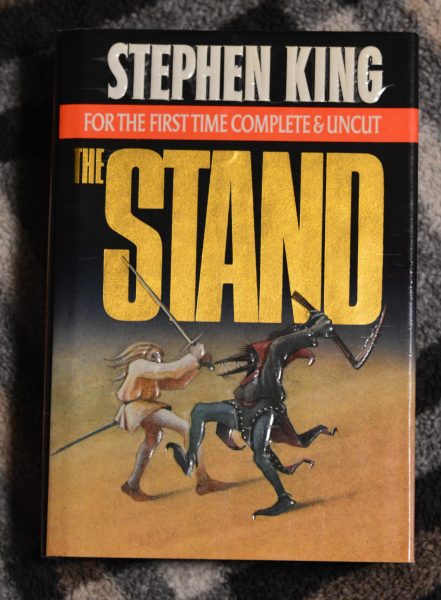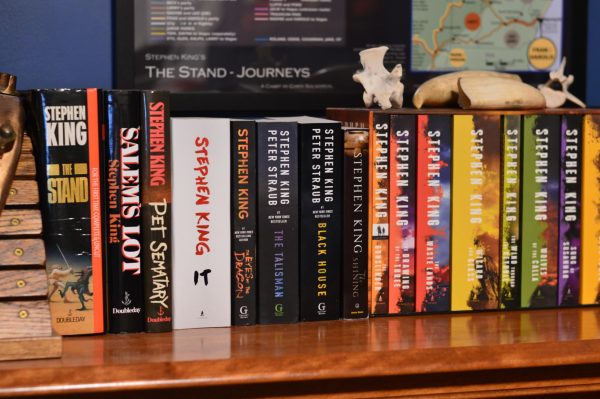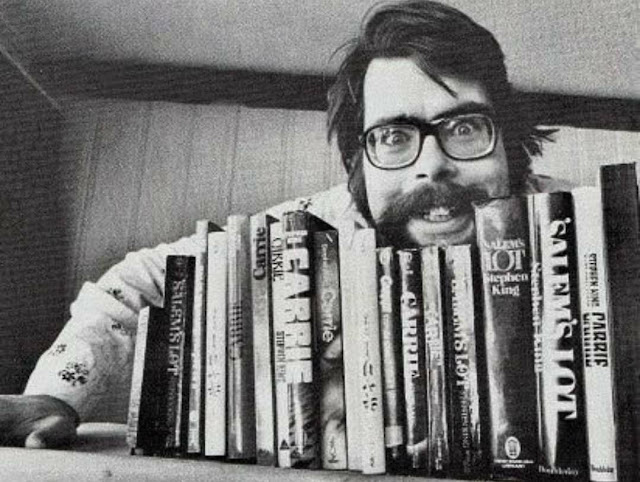Stephen King has always been hailed as the king of horror. The majority of King’s published works are horror novels or have been marketed to fit such a description. From recognizable works like It and Salem’s Lot, to lesser known works like Under the Dome and Insomnia, King has over 65 published novels/novellas under his belt. In fact, some of these works include titles under a penname of “Richard Bachmann”, which owe their existence to King’s anxiety of one specific factor: Marketing.
King began writing under the “Bachmann” penname in 1977 with his novel Rage. Due to his increasing self-doubt over his worth as an author, King drifted into the penname to test this growing concern. By starting fresh, King thought he was capable of showcasing his true talents as an author without the marketing ploy of “The King of Horror” stamped across the cover.
Ultimately, King’s concerns were answered with remarkable success in the publication industry. “Richard Bachmann” proved that Stephen King is not just the “King of Horror” ribbon on a hardcover being displayed in the bookstore window.
While the Richard Bachmann penname was able to prove to King that his own worth as an author is validated, this still leaves a burning question. How has Stephen King been able to consistently sell titles that leave readers begging for more? Well, the answer is quite simple.
Stephen King’s true talent lies in his ability to produce characters that really live on the pages. Yes, King has insane abilities when it comes to representing gruesome imagery. But, that is not what really makes his readers thirst for more. Stephen King writes characters that really feel like old friends. And you can always trust friends with your time.
The Ka-Tet

Stephen King’s first foray into epic fantasy began with the introduction of a knock-off Clint Eastwood clone, the stoic Gunslinger. The Gunslinger, titled after its temporarily nameless protagonist was faced with confusion among fans. The novel mixes its heavy “spaghetti-western” influence with a fantastical grandeur similar to Tolkien’s Lord of the Rings. The story is framed into three parts and sees the Gunslinger following the trail of a sorcerer, The Man in Black.
On the trail, the Gunslinger only interacts with few other characters. The story really begins to open up the bigger picture with the palaver between Jake Chambers and the Gunslinger. The relationship between the Gunslinger and Jake serves the foundation of the entire series, but more on that later.
King’s choice to introduce Jake Chambers completely turns the work on its head. Jake is thrust into “Mid-World” (the realm of the Gunslinger) from the real New York in 1977. The two characters are initially confused but quickly speculate that there are greater forces at play. While Jake and the Gunslinger come from entirely different cultures, they find each others’ company sufficient. Unfortunately, the Gunslinger enslaves himself to Ka (King vocabulary for ‘fate’) and undervalues Jake’s life in the face of finding the Dark Tower.
Volume two, The Drawing of the Three, introduces a stronger point of conflict for the Gunslinger, now referred to as Roland Deschain. After sacrificing Jake, Roland’s quest for the Dark Tower continues. However, this second volume paints Roland in a slightly more vulnerable state. Now missing three fingers, and reeling from his encounter with the Man in Black, Roland faces psychological struggles of a whole new caliber. This conflict is made all the more overwhelming with the introduction of Susannah and Eddie Dean.
Eddie Dean is arguably one of the greatest dynamic characters in the fantasy genre. Eddie begins his journey in sour sorts with Roland after being ripped from a scuffle with a group of heroin dealers. At first, Eddie can be characterized as stubborn, and plain annoying. This obvious culture-shock is made all the more hard to handle for Eddie, though, because of his forced sobriety from heroin. Whenever Roland speaks, Eddie rises up to challenge him. Even though Eddie’s attitude can raise chaos, he eases the tension with a humorous charm that only increases as the reader spends more time with him.
Susannah, or Odetta Holmes, also offers nuanced internal struggles. Odetta Holmes is a black woman from 1964 New York City. She was left crippled both physically and mentally by a psychopathic killer named Jack Mort. Mort caused Odetta to develop a dissociative personality called Detta Walker, and also turned her into an amputee, with both legs missing everything below the knee. Odetta/Detta terrorizes Eddie and Roland for the latter half of Volume Two due to her Detta Walker identity’s aggressive nature. This situation forces Eddie and Roland to work together, further enhancing their relationship as reluctant allies. Thankfully, Eddie and Roland are able to thwart Jack Mort’s attacks by going into the past, and the Odetta/Detta dissociation disappears. Borne from this triumph is Susannah Dean, Eddie’s eventual lover.
While Stephen King’s ability to mystify the audience with his imagination is almost hypnotizing, the true motivation for the audience to continue reading the series lies within this Ka-Tet. In the words of Roland himself, the term Ka-Tet means that the group is “bound together by fate.” This makes for a compelling dilemma shared by the Ka-Tet due to Roland’s unwavering belief in Ka (fate), and the group’s reluctance to consider Ka as anything other than myth.
By the end of the series’ third volume, The Wastelands, Roland’s band of unlikely allies is finally locked into place. Roland, Jake, Susannah, Eddie, and an additional furry friend, Oy, set out in this mysterious world with nothing but a determination to see the Tower, and their capacity to work with each other. To even learn to love each other. They are the Ka-Tet.
The Stand

If you ask most readers what they think Stephen King’s The Stand is about, they would tell you it is the story about a viral outbreak. At the extreme surface, yes. The Stand does paint a very terrifying picture of a plague developing across the United States at an alarming pace. However, The Stand‘s strength comes mainly from its wide variety of characters. A variety more than 30 characters wide.
To clarify, the publication being discussed is the The Stand: The Complete and Uncut Edition. This version of the story includes more than 500 pages of removed material, and added material after King revised his original manuscript. This edition is King’s longest novelization at 1,156 pages. The length may be discouraging to some, but upon completion it feels very deserved.
King’s decision to lengthen the novel by this hefty page count allows for more intimacy between the reader and each point-of-view character. As mentioned above, King establishes a huge cast of characters, each with their own unique worldview, backstory, personality, physicality, and relationships. The most prominently featured characters are Stuart Redman, an innocent townsman with fixed morals; Nick Andros, a misunderstood deaf-mute with excellent diplomacy skills; Larry Underwood, an impulsive singer-songwriter; Frances Goldsmith, a college-girl dealing with an unplanned pregnancy; Glen Bateman, a former sociology professor who finds a dog named Kojak; Tom Cullen, a wholesome man with special needs; Harold Lauder, a sensitive yet cynical new adult; Mother Abigail, the world’s oldest woman with an incomprehensible connection to God; and Randall Flagg, the same Man in Black from The Dark Tower. There are many more characters that King develops, but the aforementioned characters listed carry the bulk of the story.
Shockingly, King is able to balance this huge ensemble of characters with the only character really eclipsing the others being Stu Redman. Stuart Redman shares a lot of the same traits as season one Rick Grimes from The Walking Dead. He is collected, and is seen as a natural-born leader by the other people he encounters. If there were to be a selected protagonist for the story, it would be Stu.
This does not mean that Stu retains the spotlight for the whole novel. Every chapter jumps between the cast to establish a large body of people who feel like your neighbor, your sweet old grandmother, your best friends, or your worst enemies.
While many of King’s stories are bleak and shrouded in darkness, The Stand offers a beacon of light from within this darkness in the form of its morally correct characters. A highlight in the story is seeing these characters interact as real people and developing unlikely friendships and relationships with each other. For example, Nick Andros and Tom Cullen meet each other on the road and their bond becomes one of the main reasons to keep reading. King took a deaf-mute man and a man on the autism spectrum, and made their communications an extremely interesting dynamic.
There are many other incredible relationships in the novel that King creates from the ground up. The Stand is not just a meditation on a pseudo-science fueled super virus. It is a multi-dimensional meditation on a conglomerate of character studies.

To most people, the mere mention of Stephen King’s name strikes fear into them. They hear his name and immediately run to morbid thoughts as if he is some real-life version of Lord Voldemort. But from now on, when people should think of this colossal fearmonger, they should feel comforted. After all, Stephen King understands our humanities more than any other author. Thanks to him, there is always room to find friends in the darkness.




